Jiahui Wu
StructVRM: Aligning Multimodal Reasoning with Structured and Verifiable Reward Models
Aug 07, 2025

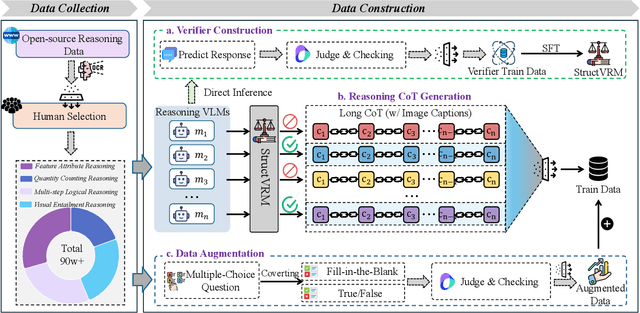
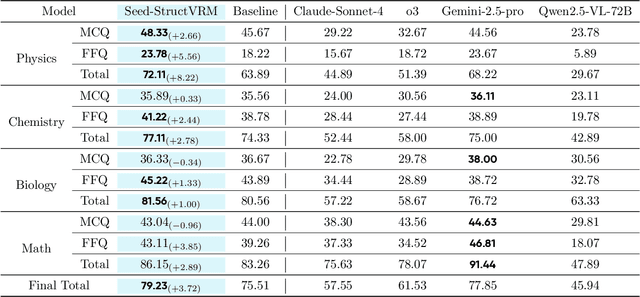
Abstract:Existing Vision-Language Models often struggle with complex, multi-question reasoning tasks where partial correctness is crucial for effective learning. Traditional reward mechanisms, which provide a single binary score for an entire response, are too coarse to guide models through intricate problems with multiple sub-parts. To address this, we introduce StructVRM, a method that aligns multimodal reasoning with Structured and Verifiable Reward Models. At its core is a model-based verifier trained to provide fine-grained, sub-question-level feedback, assessing semantic and mathematical equivalence rather than relying on rigid string matching. This allows for nuanced, partial credit scoring in previously intractable problem formats. Extensive experiments demonstrate the effectiveness of StructVRM. Our trained model, Seed-StructVRM, achieves state-of-the-art performance on six out of twelve public multimodal benchmarks and our newly curated, high-difficulty STEM-Bench. The success of StructVRM validates that training with structured, verifiable rewards is a highly effective approach for advancing the capabilities of multimodal models in complex, real-world reasoning domains.
UniPTMs: The First Unified Multi-type PTM Site Prediction Model via Master-Slave Architecture-Based Multi-Stage Fusion Strategy and Hierarchical Contrastive Loss
Jun 05, 2025Abstract:As a core mechanism of epigenetic regulation in eukaryotes, protein post-translational modifications (PTMs) require precise prediction to decipher dynamic life activity networks. To address the limitations of existing deep learning models in cross-modal feature fusion, domain generalization, and architectural optimization, this study proposes UniPTMs: the first unified framework for multi-type PTM prediction. The framework innovatively establishes a "Master-Slave" dual-path collaborative architecture: The master path dynamically integrates high-dimensional representations of protein sequences, structures, and evolutionary information through a Bidirectional Gated Cross-Attention (BGCA) module, while the slave path optimizes feature discrepancies and recalibration between structural and traditional features using a Low-Dimensional Fusion Network (LDFN). Complemented by a Multi-scale Adaptive convolutional Pyramid (MACP) for capturing local feature patterns and a Bidirectional Hierarchical Gated Fusion Network (BHGFN) enabling multi-level feature integration across paths, the framework employs a Hierarchical Dynamic Weighting Fusion (HDWF) mechanism to intelligently aggregate multimodal features. Enhanced by a novel Hierarchical Contrastive loss function for feature consistency optimization, UniPTMs demonstrates significant performance improvements (3.2%-11.4% MCC and 4.2%-14.3% AP increases) over state-of-the-art models across five modification types and transcends the Single-Type Prediction Paradigm. To strike a balance between model complexity and performance, we have also developed a lightweight variant named UniPTMs-mini.
Network-Based Transfer Learning Helps Improve Short-Term Crime Prediction Accuracy
Jun 10, 2024
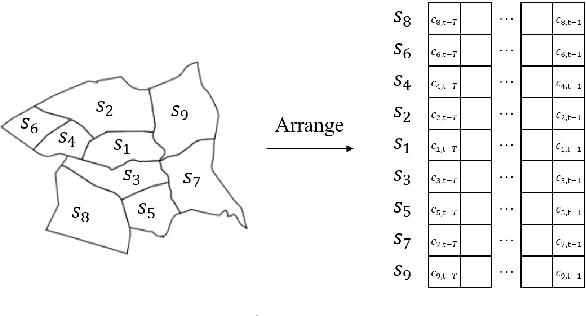
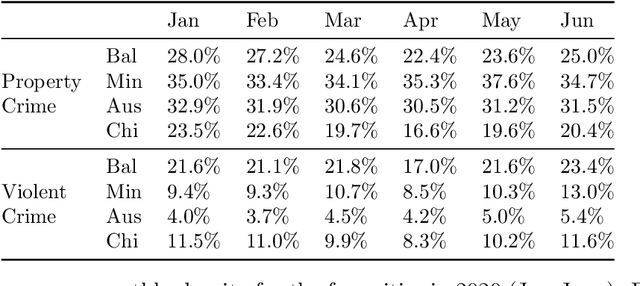
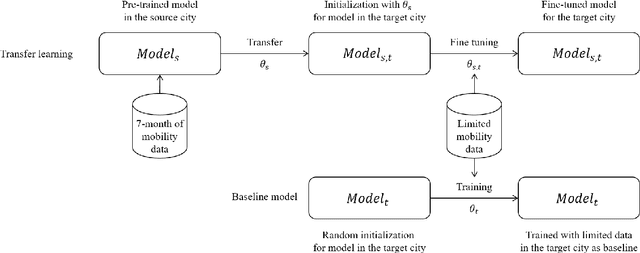
Abstract:Deep learning architectures enhanced with human mobility data have been shown to improve the accuracy of short-term crime prediction models trained with historical crime data. However, human mobility data may be scarce in some regions, negatively impacting the correct training of these models. To address this issue, we propose a novel transfer learning framework for short-term crime prediction models, whereby weights from the deep learning crime prediction models trained in source regions with plenty of mobility data are transferred to target regions to fine-tune their local crime prediction models and improve crime prediction accuracy. Our results show that the proposed transfer learning framework improves the F1 scores for target cities with mobility data scarcity, especially when the number of months of available mobility data is small. We also show that the F1 score improvements are pervasive across different types of crimes and diverse cities in the US.
Improving the Fairness of Deep-Learning, Short-term Crime Prediction with Under-reporting-aware Models
Jun 06, 2024
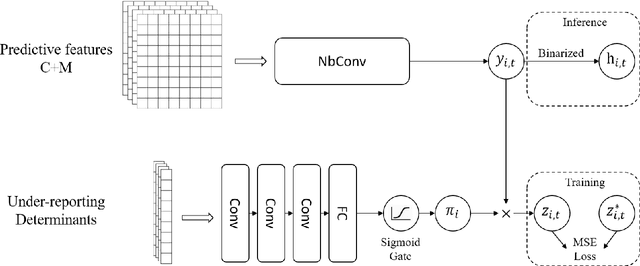
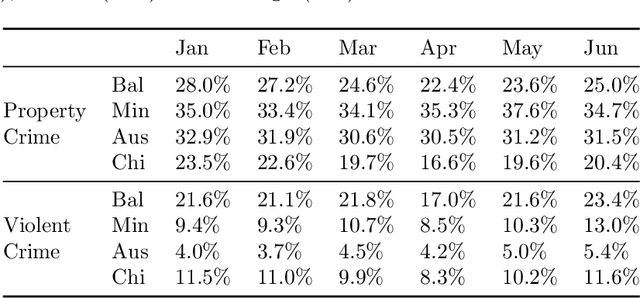
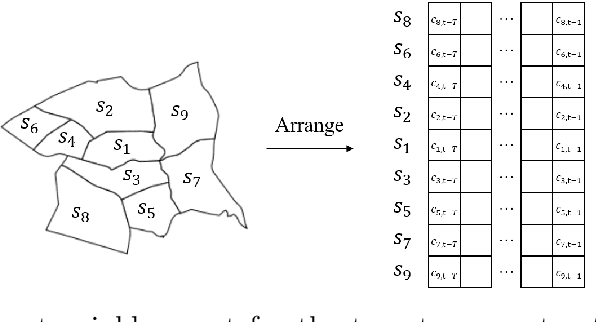
Abstract:Deep learning crime predictive tools use past crime data and additional behavioral datasets to forecast future crimes. Nevertheless, these tools have been shown to suffer from unfair predictions across minority racial and ethnic groups. Current approaches to address this unfairness generally propose either pre-processing methods that mitigate the bias in the training datasets by applying corrections to crime counts based on domain knowledge or in-processing methods that are implemented as fairness regularizers to optimize for both accuracy and fairness. In this paper, we propose a novel deep learning architecture that combines the power of these two approaches to increase prediction fairness. Our results show that the proposed model improves the fairness of crime predictions when compared to models with in-processing de-biasing approaches and with models without any type of bias correction, albeit at the cost of reducing accuracy.
Random-coupled Neural Network
Mar 26, 2024Abstract:Improving the efficiency of current neural networks and modeling them in biological neural systems have become popular research directions in recent years. Pulse-coupled neural network (PCNN) is a well applicated model for imitating the computation characteristics of the human brain in computer vision and neural network fields. However, differences between the PCNN and biological neural systems remain: limited neural connection, high computational cost, and lack of stochastic property. In this study, random-coupled neural network (RCNN) is proposed. It overcomes these difficulties in PCNN's neuromorphic computing via a random inactivation process. This process randomly closes some neural connections in the RCNN model, realized by the random inactivation weight matrix of link input. This releases the computational burden of PCNN, making it affordable to achieve vast neural connections. Furthermore, the image and video processing mechanisms of RCNN are researched. It encodes constant stimuli as periodic spike trains and periodic stimuli as chaotic spike trains, the same as biological neural information encoding characteristics. Finally, the RCNN is applicated to image segmentation, fusion, and pulse shape discrimination subtasks. It is demonstrated to be robust, efficient, and highly anti-noised, with outstanding performance in all applications mentioned above.
 Add to Chrome
Add to Chrome Add to Firefox
Add to Firefox Add to Edge
Add to Edge